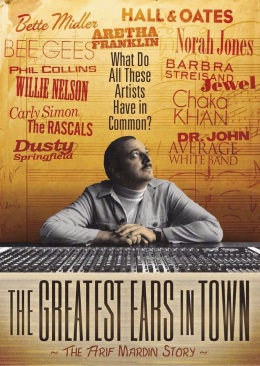There is a point in the documentary The Greatest Ears in Town: The Arif Mardin Story where the interviewer cuts to Mardin, Quincy Jones and Sir George Martin giving their individual insights about whether they, as producers, have an identifiable sound. Mardin notes that another one of his 1960s contemporaries - Phil Specter – produced records that possessed bombastic orchestrations to go with the dramatic vocals of his largely female singers, and when rock music critics and historians use the phrase “wall of sound” those familiar with the era knew they were referring to a Specter production.
In an amazing minute or so in the last third of this loving and informative documentary, we learn that’s not the way that Mardin, Jones and Martin go about producing music. Mardin simply says “I go with the artist,” and in that statement he captures the sentiments of Jones and Martin as well. That small segment reveals what’s great about the trio.
There is a point in the documentary The Greatest Ears in Town: The Arif Mardin Story where the interviewer cuts to Mardin, Quincy Jones and Sir George Martin giving their individual insights about whether they, as producers, have an identifiable sound. Mardin notes that another one of his 1960s contemporaries - Phil Specter – produced records that possessed bombastic orchestrations to go with the dramatic vocals of his largely female singers, and when rock music critics and historians use the phrase “wall of sound” those familiar with the era knew they were referring to a Specter production.
In an amazing minute or so in the last third of this loving and informative documentary, we learn that’s not the way that Mardin, Jones and Martin go about producing music. Mardin simply says “I go with the artist,” and in that statement he captures the sentiments of Jones and Martin as well. That small segment reveals what’s great about the trio.
Think about it. You really can’t talk about music history of the last half century without discussing these three legends and the artists they produced, and the genius of all of them can be summed up in that statement by Mardin, who passed away from pancreatic cancer in 2006. There is no Quincy Jones sound. He arranged for Frank Sinatra, produced Leslie Gore in the 1960s and produced George Benson, James Ingram and Michael Jackson in the 1980s. Martin is best known for his work with The Beatles. However, the Fab Four that we met in 1963 sounded nothing like the Let It Be Beatles of 1970.
Mardin started out producing The Young Rascals, Dusty Springfield and Aretha Franklin in the 1960s and ended his career working on projects by Norah Jones and Raul Midon in the first decade of the 21st Century. In between he produced artists such as Bette Midler, The Average White Band, Willie Nelson, Donny Hathaway and The Bee Gees.
The Greatest Ears in Town tells the story of Mardin’s life and work and of the project that consumed the last months of his life – his own. Mardin. That project, titled “All My Friends Are Here,” is comprised nearly entirely of tunes that Mardin composed and he served as producer at some point for the vocalists who lent their voices to the project. That lineup includes Franklin, Dr. John, Jones, Midon, Chaka Khan, Darryl Hall, The Average White Band and Midler, who wrote the tune that gives the movie its title. That track, the only cut on “All My Friends are Here” that was not penned by Mardin, is a swinging tribute to the Turkish born producer’s penchant for crafting hits for his artists.
The documentary begins in Turkey where Mardin, the descendant of one of the country’s leading families, decides to follow the calling of his heart to make jazz music rather than his father’s plans for him to become a lawyer. A chance meeting with Jones, who was a trumpeter in Dizzy Gillespie’s band, results in Mardin receiving a scholarship to the Berklee College of Music.
Mardin and his wife, who was his childhood sweetheart, move to Boston to attend Berklee. Mardin graduates and becomes a member of the school’s faculty. A story that ends there would be a good story of a man who comes to America and becomes a respected and productive member of the middle class. The American Dream. However, that was not Mardin’s dream and his wife, a writer and force in her own right, reminded him that he did not come to the United States to be a music teacher. He came to here to become a producer and arranger.
By pursuing his American Dream, Mardin made the dreams come true for scores of great artists by creating music that became part of our musical soundtrack. This loving documentary reminds us not only of the scope of Mardin’s accomplishments, but also of the indelible mark he has left on the lives of music lovers of the past half century. It is a fitting tribute to a musical giant. Recommended.
By Howard Dukes

